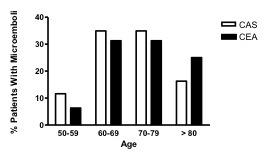|
|
 |
Back to Annual Symposium Program
Age Can Affect Incidence Of DWI Detected Microembolic Lesions Following Carotid Intervention
Mohamed Zayed, MD, PHD1, Elizabeth Hitchner, MA2, Simin Gholibeikian, MD, PHD3, Allyson Rosen, PHD1, Barton Lane, MD, PHD1, Wei Zhou, MD1.
1Stanford University, Stanford, CA, USA, 2Palo Alto VA Medical Center, Palo Alto, CA, USA, 3Palo alto VA Medical Center, Palo Alto, CA, USA.
OBJECTIVE: Diffusion weighted MRI (DWI) detected microembolic events following carotid endarterectomy (CEA) and/or carotid artery stenting (CAS) is a known phenomenon. We previously reported nearly a 40% chance of newly detected DWI microembolic events following CAS. Recent CREST trial results suggest that age is a predictor of poor outcomes following CAS. We thought to evaluate whether age is also a predictor of newly detected perioperative DWI detected microembolic events.
METHODS: From 7/2004 to 12/2010, a total of 294 patients (178 CEA and 116 CAS) underwent carotid artery interventions at a single academic institution, and also received pre- and post-operative DWI evaluations. Incidence of DWI detected microembolic events were evaluated for different age groups, and two-way ANOVA analysis with Bonferroni correction was performed.
RESULTS: Forty three (37.1%) CAS patients compared to 16 (8.9%) CEA patients had postoperative DWI lesions (P80 years old were more likely to develop postoperative DWI detected microemboli with CEA compared to CAS. In all other age groups, the incidence of microemboli was higher among patients who received CAS. Although no significant differences were observed in microemboli rates between CAS and CEA within each age group (Figure 1), two-way ANOVA analysis of the study population suggested that a patient’s age significantly affects the incidence of microemboli (P < 0.001).
CONCLUSION: Our study underscores that age is an important variable that affects the incidence of microembolic events following either CAS or CEA. Unlike other age groups, patients older than 80 years old are more likely to develop postoperative microemboli following CEA, but this difference is not statistically significant. These findings suggest that microembolic events, in addition to stroke, myocardial infarction, and death are important postoperative parameters to evaluate and may be affected by a patient’s age.

Back to Annual Symposium Program

|


